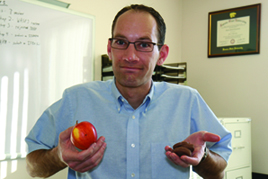Making healthy decisions
K-State researchers say availability of foods at home can make or break childhood obesity
What parents make available for their children to eat can contribute to an obesity-prone home food environment, according to researchers at K-State.
 The researchers say that when it comes to childhood obesity, a multitude of factors affect the food children consume in the home.
The researchers say that when it comes to childhood obesity, a multitude of factors affect the food children consume in the home.
"Many people view healthful eating and physical activity as an individual responsibility, but research says that we tend to eat what is available," said David Dzewaltowski, professor and head of the department of kinesiology at K-State. "So, for adults, we are driven by what is available and marketed by the food system. For children, parents are the gatekeepers of what is available at home and what out-of-home options are provided."
Richard Rosenkranz, assistant professor of human nutrition at K-State, is a former doctoral student of Dzewaltowski and worked under his guidance to compose a model of different components that contribute to an obesity-prone home food environment.
Their work, "Model of the Home Food Environment Pertaining to Childhood Obesity," is in the March 2008 Nutrition Reviews journal.
Since children's homes are the most influential environment in developing dietary behaviors, their research is meant to create a full view of the food environment from which an individual's dietary intake could be moderated, according to Rosenkranz.
The research found three types of influential environments: political and economic, built and natural, and socio-cultural.
In the political and economic environment, the study found that factors like food pricing and family socioeconomic status affect the dietary lifestyle in the home.
According to Rosenkranz and Dzewaltowski, food prices can ultimately determine what a child eats, such as when an item's price and taste trump its nutritional quality. Healthy options like fresh fruits and vegetables and lean meats are generally more expensive than energy-dense foods made from refined grains, sugars and fats.
In the socio-cultural environment, the researchers found that parenting styles can affect children's food choices.
"Parents and guardians should strive to not control their children's eating and activity, but set limits," Dzewaltowski said. "The best way to do this is to limit children's options to healthful choices."
In the built and natural environments, the researchers found that larger plates, bowls, cups and serving utensils can promote a greater consumption of food.
Rosenkranz said the healthy choice is not always the easy choice.
"There are very powerful forces at work beyond the home that can have an overwhelming influence on what a parent does to provide things for children," he said.
As examples, Rosenkranz named several factors that can lead to an obesity-inducing environment: advertising directed at children that promotes unhealthy foods; the U.S. farm bill that partly determines what foods are produced and the costs of those foods to a family; and the current economic situation that affects, among a list of numerous things, what foods families can afford.
Rosenkranz said there are some simple changes parents came make in the home to prevent their child from being overweight, such as having regular family meals with fruits and vegetables and no soda, while saving junk foods for occasions like trips to the movies or restaurants.
In addition, parents should make healthy options like fruits and vegetables easily accessible, like having vegetables readily prepared for snacking and a fruit bowl, he said.
Parents can be role models for their children and influence their attitudes about food and nutrition, Rosenkranz said.
"The worst thing a parent can do is to have and eat a lot of junk food -- like ice cream, cookies and soda -- in the home, and then to have restrictive practices with regard to allowing kids to access that junk food," Rosenkranz said. "If the kids know it is there, and parents are consuming it themselves but won't let kids have it, that is just a recipe for disaster."
An ongoing $77,501 grant from the Sunflower Foundation provided funding to support the creation of the model of the home food environment.
Photo: Richard Rosenkranz, assistant professor of nutrition, illustrates the decisions kids are faced with about the availability of foods at home. In one hand he holds an apple. In the other, chocolate-covered cookies.